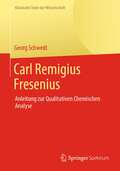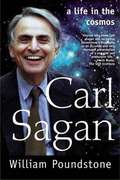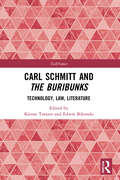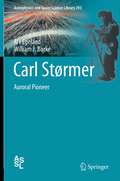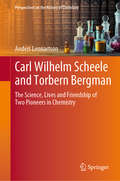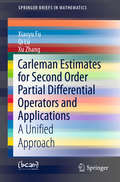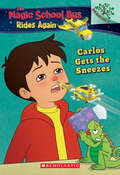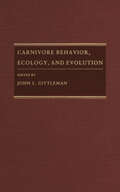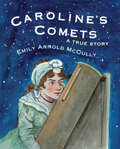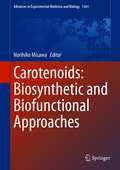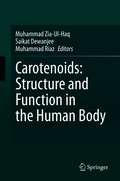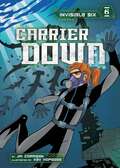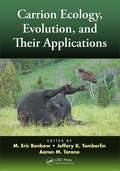- Table View
- List View
Carl Friedrich von Weizsäcker: Pioneer Of Physics, Philosophy, Religion, Politics And Peace Research (SpringerBriefs on Pioneers in Science and Practice #21)
by Ulrich BartoschThis book offers a collection of texts by Carl Friedrich von Weizsaecker (1912-2007), a major German universal scientist who was a pioneer in physics, philosophy, religion, politics and peace research. He started as an assistant to the physicist, Werner Heisenberg, held professorships in theoretical physics (Strasbourg), physics (Goettingen) and philosophy (Hamburg) and was a co-director (with Juergen Habermas) of a Max Planck Institute for Research into living conditions in a world of science and technology in Starnberg. This unique anthology spans the wide scope of his innovative thinking including his philosophical self-reflections, on peace, nuclear strategy, security and defensive defense, on nuclear energy, on the conditions of freedom, on his experience of religion, including poetry from his early youth. Most texts appear in English for the first time and are selected for use in seminars on physics, philosophy, religion, politics and peace research.
Carl Gustav Jung: A Biography
by Frank McLynnIn this, the first full-length biography of the great Swiss psychologist, Carl Gustav Jung is remembered not only for his valuable contribution to psychotherapy and to our understanding of the inner workings of the mind, but for the enduring controversies he sparked. In Frank McLynn's capable hands, readers will come to understand the man who originated what are widely held to be some of the greatest ideas of this century.
Carl Remigius Fresenius: Anleitung zur Qualitativen Chemischen Analyse (Klassische Texte der Wissenschaft)
by Georg SchwedtAb der Mitte des 19. Jahrhunderts entwickelte der bei Justus Liebig in Gießen promovierte und habilitierte Apotheker und Chemiker C. R. Fresenius seine Methodik der qualitativen und quantitativen anorganisch-chemischen Analytik. Die praktischen Grundlagen für seine 1841 erstmals in Bonn erschienene „Anleitung zur qualitativen chemischen Analyse“ hatte er im pharmazeutischen Privatinstitut des Apothekers Clamor Marquart (1804-1881) beim Studium an der Universität Bonn erworben. Daraus entstand ein für die Praxis geeigneter systematischer Analysen- und Trennungsgang, der sich vor allem in der Ausbildung von Anfängern bewährte. Bereits in Liebigs Laboratorium wandte er sich der Analytik von Mineralwässern zu, die er im Verlaufe von Jahrzehnten zu einer hohen Perfektion entwickelte. 1842 bzw. 1844 erschienen die nächsten Auflagen seiner Anleitung zur qualitativen Analyse. 1846 folgte die „Anleitung zur quantitativen chemischen Analyse“ und zugleich erschien auch die 4. Auflage seines Erstlingswerkes. Beide Anleitungsbücher entwickelten sich zu Standardwerken der Analytischen Chemie, die bis in das 20. Jahrhundert immer wieder aufgelegt wurden. Die von ihm entwickelten Trennungsgänge wurden auch im Chemiestudium in den Grundpraktika bis zum Ende das 20. Jahrhunderts angewendet.
Carl Sagan: A Life in the Cosmos
by William PoundstoneIn this compelling life of Carl Sagan, award-winning science writer William Poundstone details the transformation of a bookish young astronomer obsessed with life on other worlds into science's first authentic media superstar. The instantly recognizable Sagan, a fixture on television and a bestselling author, offered the layperson entry into the mysteries of the cosmos and of science in general. To much of the scientific community, however, he was a pariah, a brazen publicity seeker who cared more about his image and his fortune than the advancement of science. Poundstone reveals the seldom-discussed aspects of Sagan's life, the legitimate and important work of his early scientific career, the almost obsessive capacity to take on endless projects, and the multiple marriages and fractured personal life, in what The New Yorker called an "evenhanded guide" to a great man's career.
Carl Schmitt and The Buribunks: Technology, Law, Literature (TechNomos)
by Kieran TranterIn 1918 a young Carl Schmitt published a short satirical fiction entitled The Buribunks. He imagined a future society of beings who consistently wrote and disseminated their personal diaries. Schmitt would go on to become the infamous philosopher of the exception and for a while the ‘Crown Jurist of the Third Reich’. The Buribunks – ironically for beings that lived only for self-memorialisation – has been mostly lost to history. However, the digital realm, with its emphasis on the informatic traces generated by human doing, and the continual interest in Schmitt’s work to explain and criticise contemporary constellations of power, suggests that The Buribunks is a text whose epoch has come. This volume includes the first full translation into English of The Buribunks and a selection of critical essays on the text, its meanings in the digital present, its playing with and criticism of the literary form, and its place within Schmitt’s life and work. The Buribunks and the essays provide a complex, critical and provocative invitation to reimagine the relations between the human and their imprint and legacy within archives and repositories. There is a fundamental exploration of what it means to be a being intensely aware of ‘writing itself’. This is not just a volume for critical lawyers, literary scholars and the Schmitt literati. It is a volume that challenges a broad range of disciplines, from philosophy to critical data studies, to reflect on the digital present and its assembled and curated beings. It is a volume that provides a set of fantastically located concepts, images and histories that traverse ideas and practices, play and politics, power and possibility.
Carl Størmer: Auroral Pioneer (Astrophysics and Space Science Library #393)
by Alv Egeland William J. BurkeThis biography summarizes the seminal contributions to auroral and space science of Carl Størmer (1874 - 1957). He was the first to develop precise photographic methods to calculate heights and morphologies of diverse auroral forms during four solar cycles. Størmer independently devised numerical techniques to determine the trajectories of high-energy charged particles allowed and forbidden in the Earth's magnetic field. His theoretical analyses explained cosmic ray access to the upper atmosphere, 20 years before they were identified by other scientists. Størmer's crowning achievement, "The Polar Aurora," published when he was 81 years old, stands to this day as a regularly cited guide in graduate-level courses on space physics. The authors present the life of this prodigious scientist in relation to the cultural life of early 20th century in Norway and to the development of the space sciences in the post-Sputnik era.
Carl Wilhelm Scheele and Torbern Bergman: The Science, Lives and Friendship of Two Pioneers in Chemistry (Perspectives on the History of Chemistry)
by Anders LennartsonThis book tells the story of two of the most important figures in the history of chemistry. Carl Wilhelm Scheele (1742–1786) was the first to prepare oxygen and realise that air is a mixture of nitrogen and oxygen; he also discovered many important organic and inorganic substances. His fellow chemist and good friend, Torbern Bergman (1735–1784), was one of the pioneers in analytical and physical chemistry. In this carefully researched biography, the author, Anders Lennartson, explains the chemistry of Scheele and Bergman while putting their discoveries in the context of other 18th-century chemistry. Much of the information contained in this work is available in English for the first time.
Carleman Estimates for Second Order Partial Differential Operators and Applications: A Unified Approach (SpringerBriefs in Mathematics)
by Qi Lü Xu Zhang Xiaoyu FuThis book provides a brief, self-contained introduction to Carleman estimates for three typical second order partial differential equations, namely elliptic, parabolic, and hyperbolic equations, and their typical applications in control, unique continuation, and inverse problems. There are three particularly important and novel features of the book. First, only some basic calculus is needed in order to obtain the main results presented, though some elementary knowledge of functional analysis and partial differential equations will be helpful in understanding them. Second, all Carleman estimates in the book are derived from a fundamental identity for a second order partial differential operator; the only difference is the choice of weight functions. Third, only rather weak smoothness and/or integrability conditions are needed for the coefficients appearing in the equations. Carleman Estimates for Second Order Partial Differential Operators and Applications will be of interest to all researchers in the field.
Carlos Gets the Sneezes: A Branches Book (The Magic School Bus Rides Again #3)
by Judy KatschkeHop aboard--again! The Magic School Bus is back in a brand-new Netflix TV show.This series is part of Scholastic's early chapter book line called Branches, which is aimed at newly independent readers. With easy-to-read text, high-interest content, fast-paced plots, and illustrations on every page, these books will boost reading confidence and stamina. Branches books help readers grow!Seatbelts, everyone! The Magic School Bus is back and ready to ride again. Professor Frizzle's kid sister Fiona might be the new teacher at Walkerville Elementary, but she's got the same old motto: take chances, make mistakes, and get messy! Carlos desperately wants a classroom pet and he's got the perfect idea-- a rat! But when Carlos can't stop sneezing, the class has to figure out what's going on, so they head straight to the source--his body!
Carnivoran Evolution: New Views on Phylogeny, Form and Function
by Anjali Goswami Anthony FrisciaMembers of the mammalian clade Carnivora have invaded nearly every continent and ocean, evolving into bamboo-eating pandas, clam-eating walruses and of course, flesh-eating sabre-toothed cats. With this ecological, morphological and taxonomic diversity and a fossil record spanning over sixty million years, Carnivora has proven to be a model clade for addressing questions of broad evolutionary significance. This volume brings together top international scientists with contributions that focus on current advances in our understanding of carnivoran relationships, ecomorphology and macroevolutionary patterns. Topics range from the palaeoecology of the earliest fossil carnivorans to the influences of competition and constraint on diversity and biogeographic distributions. Several studies address ecomorphological convergences among carnivorans and other mammals with morphometric and Finite Element analyses, while others consider how new molecular and palaeontological data have changed our understanding of carnivoran phylogeny. Combined, these studies also illustrate the diverse suite of approaches and questions in evolutionary biology and palaeontology.
Carnivore Behavior, Ecology, and Evolution
by John L. GittlemanCarnivores have always fascinated us, even though they make up only 10% of all mammalian genera and only about 2 % of all mammalian biomass. In Greek mythology most of the gods adorned their robes and helmets with depictions of carnivores, and the great hero Hercules' most famous feat was killing the "invulnerable" lion with his bare hands. Part of our fascination with carnivores stems from fright and intrigue, and sometimes even hatred because of our direct competition with them. Cases of "man-eating" lions, bears, and wolves, as well as carnivores' reputation as killers of livestock and game, provoke communities and govermllents to adopt sweeping policies to exterminate them. Even President Theodore Roosevelt, proclaimer of a new wildlife protectionism, described the wolf as "the beast of waste and desolation. " The sheer presence and power of carnivores is daunt ing: they can move quickly yet silently through forests, attaining rapid bursts of speed when necessary; their massive muscles are aligned to deliver powerful attacks, their large canines and strong jaws rip open carcasses, and their scis sor-like carnassials slice meat. Partly because of our fear of these attributes, trophy hunting of carnivores has been, and to a certain extent still is, a sign of bravery and skill. Among some Alaskan Inuit, for example, a man is not eligible for marriage until he has killed a succession of animals of increasing size and dangerousness, culminating with the most menacing, the polar bear.
Carnivore Minds: Who These Fearsome Animals Really Are
by G. A. BradshawMyth and media typically cast animals we consider predators or carnivores as unthinking killers--dangerous, unpredictable, and devoid of emotion. But is this portrait valid? By exploring their inner lives, this pioneering book refutes the many misperceptions that hide the true nature of these animals. We discover that great white sharks express tender maternal feelings, rattlesnakes make friends, orcas abide by an ancient moral code, and much more. Using the combined lenses of natural history, neuroscience, and psychology, G. A. Bradshaw describes how predators share the rainbow of emotions that humans experience, including psychological trauma. Renowned for leading research on post-traumatic stress disorder (PTSD) in elephants and other species, Bradshaw decries the irrational thinking behind wildlife policies that equate killing carnivores with "conservation. " In its place, she proposes a new, ethical approach to coexistence with the planet's fiercest animals.
Caroline's Comets: A True Story
by Emily Arnold McCullyWith courage and confidence, Caroline Herschel (1750-1848) becomes the first woman professional scientist and one of the greatest astronomers who ever lived. Born the youngest daughter of a poor family in Hanover, Germany, Caroline was scarred from smallpox, stunted from typhus, and used by her parents as a scullery maid. But when her favorite brother, William, left for England, he took her with him. The siblings shared a passion for stars, and together they built the greatest telescope of their age, working tirelessly on star charts. Using their telescope, Caroline discovered fourteen nebulae and two galaxies, was the first woman to discover a comet, and became the first woman officially employed as a scientist--by no less than the King of England. The information from the Herschels' star catalogs is still used by space agencies today. The book includes excerpts from Caroline Herschel's autobiography. A 2018 NSTA-CBC Outstanding Science Trade Book for Students K-12.
Carotenoids and Retinal Disease
by John T. Landrum John M. NolanxThe macular carotenoids play key roles in eye health and retinal disease. Age-related macular degeneration (AMD), the most common cause of acquired blindness in much of the world, is associated with low levels of macular pigment. Macular pigment is also essential for enhancing visual performance by reducing glare disability and improving photostres
Carotenoids and Vitamin A in Translational Medicine (Oxidative Stress and Disease)
by Klaus Kraemer Werner Siems Olaf SommerburgVitamin A (retinol) is an essential dietary compound with myriad metabolic and regulatory functions. Deficiency can result in vision problems, compromised immune responses, and a host of other medical issues. More than 600 carotenoids have been identified in plants, algae, fungi, and bacteria, and around 50 carotenoids-includingcarotene-can be co
Carotenoids: Biosynthetic and Biofunctional Approaches (Advances in Experimental Medicine and Biology #1261)
by Norihiko MisawaThis book provides a comprehensive overview of carotenoid biosynthesis by different organisms, including bacteria, archaea, fungi, arthropods, and plants. Carotenoids are thought to provide health benefits in areas such as cancer, diabetes, osteoporosis, NAFLD, NASH, obesity, age-related functional decline, and as a result, they have received an increasing amount of attention.With contributions from leading experts in biology, biotechnology, and chemistry of carotenoid research, this volume discusses the biological functions of carotenoids such as astaxanthin, β-cryptoxanthin, and fucoxanthin, in addition to paprika carotenoids, capsanthin, and capsorubin. It also reveals the technologies behind the commercial production of some functional carotenoids.The book is targeted for academic and industrial readers in biology, biotechnology, nutrient physiology and related fields.
Carotenoids: Physical, Chemical, and Biological Functions and Properties
by John T. LandrumCarotenoids are of great interest due to their essential biological functions in both plants and animals. However, the properties and functions of carotenoids in natural systems are surprisingly complex. With an emphasis on the chemical aspects of these compounds, Carotenoids: Physical, Chemical, and Biological Functions and Properties presents a b
Carotenoids: Structure and Function in the Human Body
by Muhammad Riaz Muhammad Zia-Ul-Haq Saikat DewanjeePlants produce chemicals as part of their normal metabolic activities. These include primary metabolites found in all plants, such as sugars and fats, as well as secondary metabolites, which can have therapeutic effects in humans and be refined to produce drugs. Plants synthesize a bewildering variety of phytochemicals, but most are derivatives of a few biochemical motifs. Numerous herbal-derived substances have been evaluated for their therapeutic potential. These include alkaloids, coumarins, saponins, plant pigments and flavonoids. Flavonoids, carotenoids and anthocyanins are probably the best known of these substances due to their antioxidant properties. Carotenoids: Structure and Function in the Human Body presents comprehensive coverage of carotenoids. The text covers the scientific literature and clinical significance of this organic pigment, with an emphasis on its therapeutic potential. The authors approach carotenoids from a range of perspectives, from their structural and physicochemical properties to their distribution in nature, interaction with the human metabolism, and use as a coloring agent in various products. The intake, metabolism and secretion of anthocyanins in the human body are covered in-depth, as are the biosynthetic pathways through which these compounds are synthesized in the natural system. Factors affecting stability and extraction are listed, and health-related uses and biological activities are covered in great detail. Present and future trends in carotenoid research are also presented. This book provides a solid background in carotenoids for researchers and professionals in food science, food technology, nutrition, biology, chemistry and medical sciences.
Carotenoids: Trends and Advances
by Mozaniel Santana de Oliveira Renan Campos Chisté Eloisa Helena de Aguiar AndradeCarotenoids are one of the most important groups of bioactive compounds in nature. They have been used in the food, cosmetic and pharmaceutical industries due to their wide range of chemical and biological properties. Currently, industrial use of carotenoids comes from chemical synthesis, but greener and biotechnological engineering approaches for carotenoid production are coming into focus. The public has also become aware of the therapeutic and health benefits of carotenoids, making them an increasingly popular with consumers. Carotenoids: Trends and Advances focuses on recent advances in biosynthesis of carotenoids in foods, plants, microorganisms and insects as well as health benefits and therapeutic uses. Advanced production techniques and technologies are focused on, including biotechnological engineering approaches and agricultural methods. Recent approaches for the bioaccessibility and bioavailability of carotenoids are covered infull. The preservation of the bioactivity of carotenoids through encapsulation and biofortification is a major focus, with extensive coverage of green processes. The text provides a comprehensive update for researchers across a wide range of relevant industries interested in the most current advances in carotenoids.
Carraher's Polymer Chemistry
by Charles E. Carraher Jr.Carraher's Polymer Chemistry, Tenth Edition integrates the core areas of polymer science. Along with updating of each chapter, newly added content reflects the growing applications in Biochemistry, Biomaterials, and Sustainable Industries. Providing a user-friendly approach to the world of polymeric materials, the book allows students to integrate their chemical knowledge and establish a connection between fundamental and applied chemical information. It contains all of the elements of an introductory text with synthesis, property, application, and characterization. Special sections in each chapter contain definitions, learning objectives, questions, case studies and additional reading.
Carrion Ecology and Management (Wildlife Research Monographs #2)
by Pedro P. Olea Patricia Mateo-Tomás José Antonio Sánchez-ZapataCarrion, or dead animal matter, is an inherent component of aquatic and terrestrial ecosystems worldwide, and is exploited by a wide diversity of organisms from different trophic levels, including microbes, arthropods and vertebrates. Further, carrion consumption by scavengers, i.e. scavenging, supports key ecosystem functions and services such as recycling nutrients and energy, disposing of carcasses and regulating disease spread. Yet, unlike dead plant matter, dead animal decomposition has received little attention in the fields of ecology, wildlife conservation and environmental management, and as a result the management of carrion for maintaining biodiversity and functional ecosystems has been limited. This book addresses the main ecological patterns and processes relating to the generation and consumption of carrion both in terrestrial and aquatic ecosystems. It also discusses a number of conservation concerns and associated management issues, particularly regarding the increasing role of human-mediated carrion in ecosystems. Lastly, the book outlines future research lines in carrion ecology and management, and identifies the major challenges for scavengers and scavenging processes in the Anthropocene.
Carrion Ecology, Evolution, and Their Applications
by M. Eric Benbow Jeffery K. Tomberlin Aaron M. TaroneShortlisted for the 2018 TWS Wildlife Publication Awards in the edited book categoryDecomposition and recycling of vertebrate remains have been understudied, hampered largely due to these processes being aesthetically challenging (e.g., smell and sight). Technological innovations have provided the means to explore new and historically understo
Carrion Ecology, Evolution, and Their Applications
by M. Eric Benbow, Jeffery K. Tomberlin, and Aaron M. TaroneThe first edition of Carrion Ecology, Evolution, and Their Applications brought together multiple scientific disciplines to shed light on the importance of carrion within the context of ecology and evolutionary biology, and through applications ranging from human mass disasters to habitat/ecosystem conservation. This second edition builds upon this foundation to include a huge amount of new research, consisting of 33 chapters—9 brand new and the remaining 24 substantially updated and expanded. One of the most significant changes for this edition is the coverage of aquatic ecosystems, both freshwater and marine.The book is now represented by 73 authors from eight countries, incorporating more diverse perspectives and engagement into this multidisciplinary and expanding science. The resulting new edition showcases a broader scope of topics, geographic areas, ecosystems and history of carrion ecology, evolution, and their applications for humanity. It provides the most comprehensive resource on carrion from all ecosystems of the world.The student, academic, and professional will find this book insightful, providing new insights for the fields of molecular ecology, microbiology, entomology, population biology, community and ecosystem ecology, as well as applications in forensics and human and environmental health.
Carrots and Related Apiaceae Crops (Crop Production Science in Horticulture)
by Richard Smith François Villeneuve Rosemary Rosemary Dariusz Grzebelus Charlotte J Allender Jean-Pierre Bouverat-Bernier Benjamin Z Bradford Mathilde Briard Ewa Capecka Justin R Clements Micaela Colley Jed Colquhoun Valentine Cottet Luigi Filippo D’Antuono Simone Gaeta Philippe Gallois Philippe Gallotte Jacky Granger Russell L Groves Sébastien Huet Ramon Jamez Valérie Le Clerc Simon Lemiere Amy M Lucas Mary Ruth McDonald Nuno Madeiro Frank Marthe Narges Moradi Eduardo Morillo Brigitte Navez Juan J Nunez Harold C Passam Federica Pollastro Jean-Pierre Reduron Seyed Ahmad Noori Mehdi Soltani Howyzeh Cameron J Spurr Alan WaltonFully updated with new content and full-colour figures, the second edition of this successful book reflects developments and growth in our knowledge of carrots and related crops worldwide. It covers the scientific basis of their biology and production, with updated technical crop management content. This new edition is divided into three sections: the first considers the crops' importance and main features; the second focuses on carrot, from genetic diversity and breeding to cropping systems, pest and disease management, quality, postharvest and valorization; and the third presents the main aspects of 13 other cultivated Apiaceae. Containing a dedicated chapter on root-quality plus new chapters on organic production and consumer expectations, this book also: Highlights both unique and shared characteristics among cultivated Apiaceae species. Describes the links between scientific principles and cropping systems. Explores the relationship between crop management and product quality. An invaluable resource for all those involved in carrot and related vegetable production, this is essential reading for producers, and horticulture, plant science and food science students, as well as researchers in these areas.


